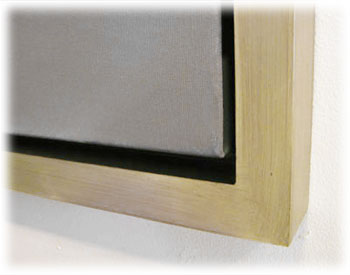Custom Framing
The Art of Conservation Framing
For framing purposes, we separate art into two categories: art on canvas / panel and art on paper.
Canvas framing is simple, the choice is whether or not to cover the edge. This is an aesthetic question, determined by the artwork itself, and the setting in which it will be displayed.
We manufacture custom depth, custom finished floater frames, a frame that does not cover the edge of the canvas, but merely creates a border for the art. If you want to cover the edge of the canvas, one of our seamless corner leafed frames can be a great choice.


Framing art on paper, including photographs, documents and other memorabilia.
Elements of a Quality Frame


The Frame:
A frame should be simply that, a frame. Its job is to protect the artwork and set it apart from the environment where it is displayed. It should never compete with the art for your attention.
We manufacture frames that are custom finished, to complement the art and your interior design. We can round corners and/or make them appear seamless. Natural wood, painted and leaf finishes are available.
The Glazing:
The glazing, usually glass, helps protect the art from the environment. Sunlight, dirt, and smoke are the major enemies. We use conservation glass that blocks 97% of ultraviolet radiation. A relatively new product, the visual deference between this and regular glass is imperceptible. UV acrylic is recommended for pieces larger than 40×60. In situations where reflection is a problem, we use Museum glass.
Space:
Fine art must never come in contact with glass or acrylic. The amount of space necessary varies with the media and the aesthetic of the piece. A four or eight ply mat is usually sufficient, though space can be created in a variety of ways.
The Mat:
Aesthetically, the mat creates a border between the artwork and the frame, a visual pause that enhances the look of the art. Functionally, the job of the mat is to create space between the art and the glass, hold the artwork flat and provide additional support. We use acid-free board for all of our mats. We have many colors of acid-free board, 100% rag board, and fabric-covered board available for an elegant handcrafted look. Check out our Mat and Filet options here!
Attaching the artwork:
We use the following criteria: Anything that comes in contact with the artwork must be PH neutral. Anything that is attached to the artwork must be completely reversible without leaving any scar or residue. This is an area where what you don’t see can hurt your artwork.
The Backboards:
There are usually two. The first is the board on which the artwork is mounted. Fine Art Frames uses 100% rag board wherever possible, however size limitations apply. A second acid free board is used behind the rag board to brace and stiffen the package.
The Dust-cover:
This acid-free breathable material covers the back of the frame and completes the package. Fine Art Frames uses Tyvek.